Claude Monet - the founder of Impressionism and his eternal inspiration
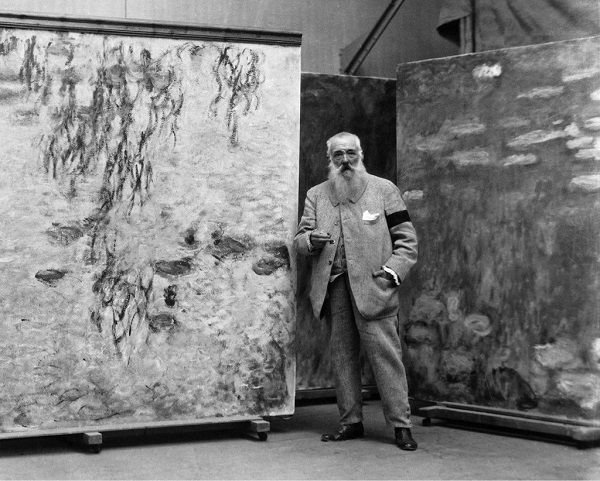
There are not many creators in history who can tell that they have managed to create a great world movement in art Well, Claude Monet is an example of the few who wrote their name in golden letters in history - the founder of Impressionist painting in France. He is the most significant and defining practitioner of the philosophical movement, who believes that the expression of human emotions, thoughts, ideas, and worldviews are unconditionally related to nature. Monet uses various techniques and types of paints to achieve his ambition to document the idyllic paintings of the beautiful, colorful and tranquil French province. A curious technique is his idea of painting the same landscape several times in order to fully build in his paintings the different and unique feeling through all the variations of the seasons and the change of light and colors. Monet moved to Giverny in 1883 when he bought a home in the area and began his big project involving the many lilies in the area. Landscapes that will later turn into some of his most famous and genius works.
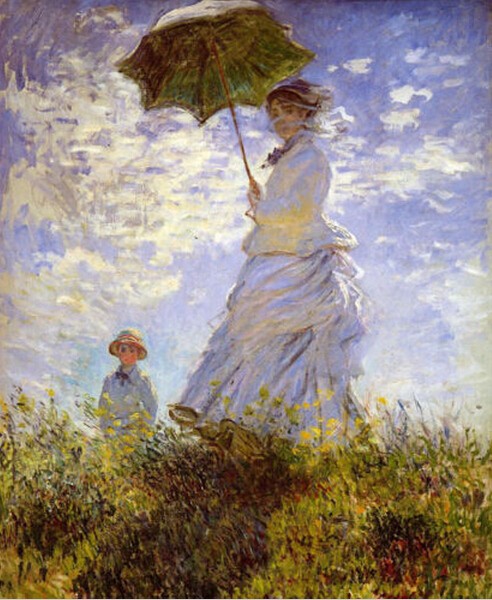
"The Woman with the parasol child in summer", Monet
Claude Monet was born in 1840. His parents call him Oscar, and on May 20, 1841, he was introduced into the Roman Catholic faith. However, he remains an atheist throughout his life. Moving along with his whole family to Le Havre in 1845, he was named by his father as the heir to run the family grocery business and load the commodity by traveling to the most important port cities in Europe. Claude Monet, however, has his own different young for his life - he insisted on being an artist. His mother supported him in the decision to pursue a career in art, as she is a singer. Claude began drawing lessons at Le Havre High School, where he enrolled on April 1, 1851. He began painting everything he saw through the window. In his desire to develop, he departed for the capital of Paris, where he remained for many years, and managed to make friends with other young artists who later became, except in friends and colleagues impressionists. Monet painted several works related to the modern way of life during the Franco-Prussian war despite the fact that his family is living in extreme poverty.
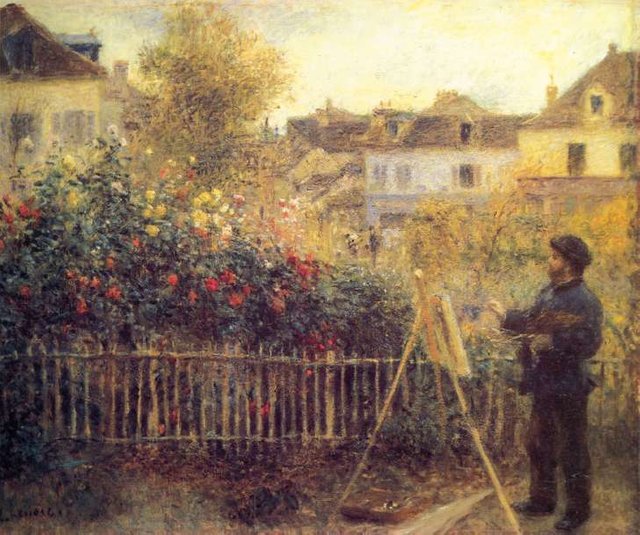
"Claude Monet painting in his Garden" By Pierre-Auguste Renoir 1873
One of Monet's most famous works is the painting series Ruen Cathedral, which he painted in the period 1892-1893. The series of works aims at capturing the facade of the Ruen Cathedral in France, showing the changing light, atmosphere and spirit at different times of the day and year. Mona uses only an element of the cathedral so that the canvas reveals only part of the facade. Monet has created dozens of paintings related to natural and urban landscapes in Le Havre, Paris and dozens of French towns. World success achieved a series of works inspired by water lilies. This painting cycle was painted in the period 1896-1926. Monet paint creates about 250 oil paintings, which are currently exhibited in the most prestigious museums in the world. The complexity of Claude Monet's work on the lilies and colors of the water lilies creates a sense of the incredible diversity, richness and gentle mystery of the meaning of life.
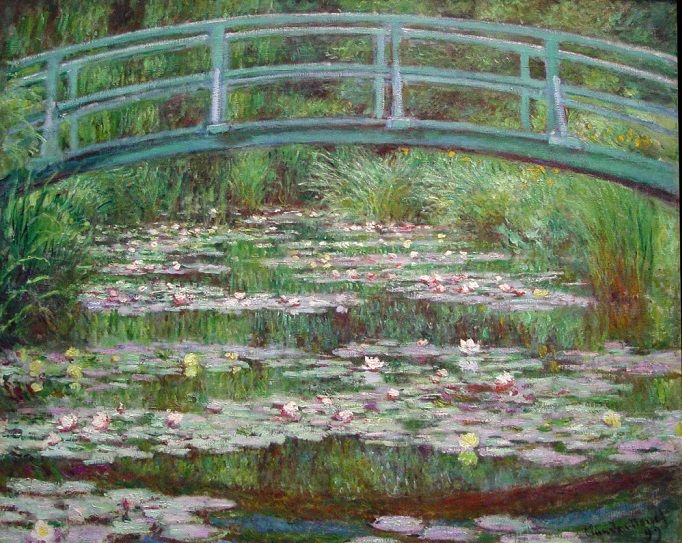
Claude Monet burns the paintings that his creditors want
Claude Monet is an icon in art. Apart from being endowed with a unique talent, the artist also had a unique character - he was a very stubborn man. And at his most critical moments, he refused to sell his paintings to people he did not like. Once he even burned some of his sails so they would not fall into the hands of the creditors. And the most curious thing is that he plays a lot of money on the lottery and sinks into loans that do not give him peace of mind. He has to paint to solve his financial problems. It seems fate knew what he was doing to make him paint ... Oscar, as lost his mother when he was 16 years old, and moved to live with his aunt, a widow and an infertile woman. Fate meets him with his future mentor Eugen Bouden. It is he who teaches him to work with oil and outdoors. Monet began to paint his incredible landscapes. To them he was particularly jealous and did not want his canvases to be owned by anyone. Especially heavily he experienced the moment when the creditors hit his canvases in 1860 because the poor artist had nothing but them. In his frustration, Monet performs something that is difficult to imagine, but it is a fact - he burns some of his paintings. This peculiarity of his character, some called stubbornness, and other maximalism and painful sense of dignity - Monet did not allow him to be "possessed" by anyone. From a psychological point of view, burning paintings is a type of self-harm, typical of sensitive natures. In 1861, Claude Monet entered the army under a 7-year contract. At least he is provided with food. Two years later, however, he suffers from a typhoid fever and his aunt pulls him out without penalty for the contract - for health reasons. The condition is to continue studying artistic craftsmanship, but Monet does not accept traditional art and becomes a student of Charles Glear in Paris. There he meets Pierre-Auguste Renoir, Frederick Basil and Alfred Sisley - three artists with their own vision of the effects of light, broken colors and so on. "quick strokes" on the brush. It is these people who will lay the foundations of Impressionism in Fine Art.
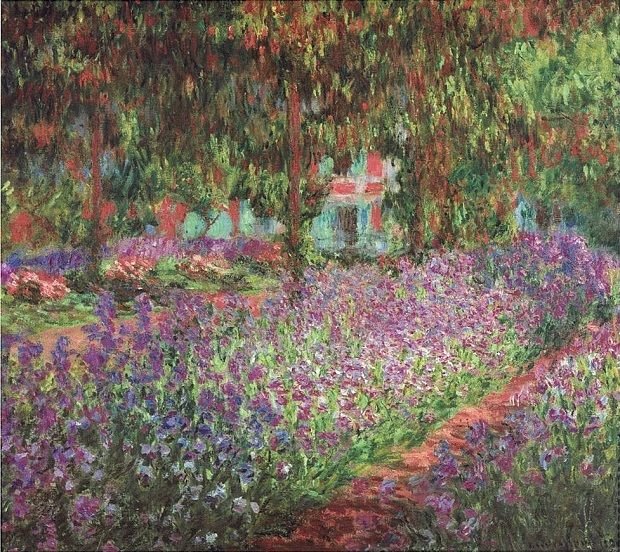
Monet Garten in Giverny
In 1866, Monet received great recognition with his painting "Camille," also known as "The Woman with the Green Dress". It depicts his future wife, Camille Donsjo, who will later be a model of many other paintings. Monet and Camille married shortly before the Franco-Prussian War in 1870. Their first child, Jean, was born. After the outbreak of war, they all went to England, where the artist was inspired by the landscapes of John Constable and Joseph Turner. In London, he met the painting trader Paul Duran-Rueel, later on, one of the greatest fans and propagandists of Impressionism. In the spring of 1871, Monnet exhibited his work at the Royal Academy in London. Shortly thereafter, Camille goes to the Netherlands. This is a particularly productive period for the artist - he painted 25 paintings there. For some reason, however, Dutch police suspect Monet in revolutionary activity, and for security reasons, Monet and Camille are quick to return to France. They are located in the village of Argentanto, in Senna, where Monet painted some of his most beautiful landscapes. In 1876, Camil began to feel sick, but he became pregnant again. In 1878, Monet's second son was born. Birth, however, further weakens Camille's resisting forces, and shortly after, she died, only 32, leaving the artist with a broken heart and two children. Monet suffers and seeks comfort from loss by painting his wife on her deathbed. Camel's pity makes him even more workaholic. After the death of his wife, Monet creates some of his best works. His sons raised Ernest Osedade's wife, a wealthy merchant and admirer of painting. Alice and Ernest have 6 of their own children, but they also take care of the sons of Monet. Actually, they all live in a common house in Bethoy, then move to Poissy, but all together. Mona does not like Poissy and one day while traveling by train, he remains fascinated by Giverny, a village in northern Normandy.
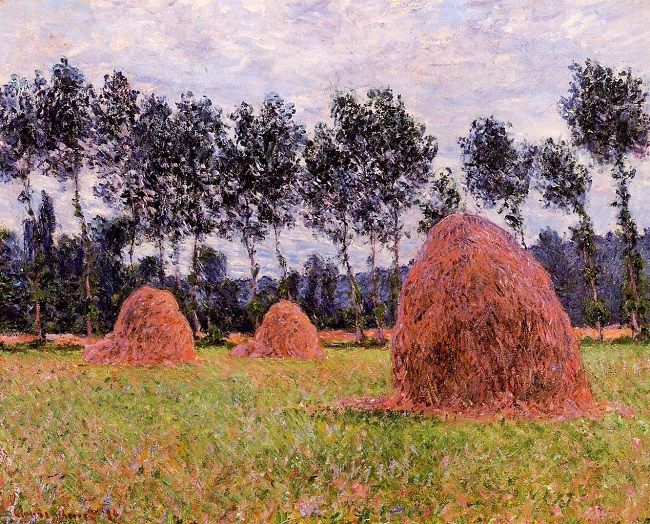
"Haystacks Overcast Day" by Claude Monet, 1884
Soon everyone moves together to live there, and in the courtyard of the Monet House he builds a beautiful garden in which he likes to paint. The artist remains in Giverny for the rest of his life. After Ernest's bankruptcy, in 1892 Alice and Claude Monet married. At their Giverny mansion, Claude Monet painted a series of beautiful paintings, among which the paintings "Buy Hay", "Morning of the Seine", "Water Lilies", etc. Since 1880 the artist's popularity has started to grow. The value of his canvases in the art market is on average 1000 francs. But the artist still chooses his clients, and when a buyer drops the price, he tells him unceremoniously that he will not give 50 francs for such a "ointment", Monet replies that he would not sell his painting to 50,000 franca. Monet is known for his courageous maximalism. They tell an interesting story about how he started painting an oak in February 1889, but then abandoned his work and appeared at the tree until May when he was already completely devoted. Monet, in a nervous crisis, how did this tree "dare" to fail his job? "-" He went to look for the owner of the place with a strange request - to allow him ... to overthrow the leaves of the oak, and then he was courageously diligent he dealt with this problem, and a rejoicing seated man to sculpt the tree as he saw it in February - without leaves! .. When he was late in completing a painting, the artist was madly irritated by the change in the landscape, hated the fog and the rainy weather, he could not work outdoors when he stood without to work, to become irritable, and to arrogantly argue, especially when they were filmed with Auguste Rodin, and once they both had the chance to make a general exhibition, and this idea became a real test of the will for Monet, born late with the sculpture and at the last moment put some of them so that they covered Monet's paintings.
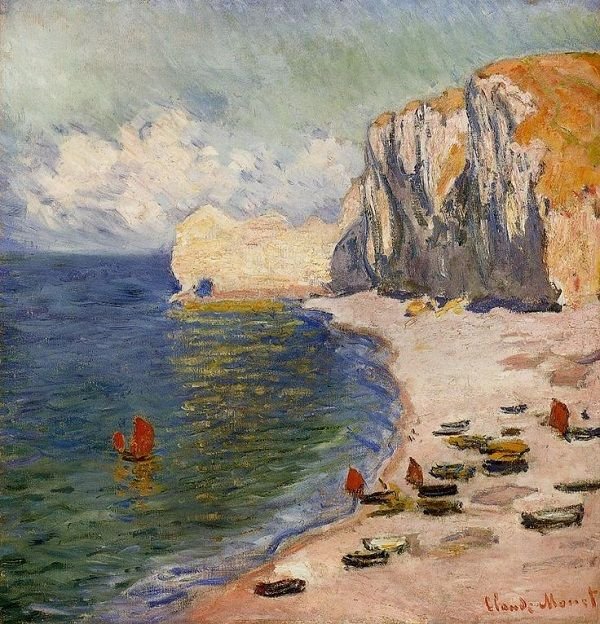
"The Beach and the Falaise d'Amont" by Claude Monet
A quarrel, which grew into a heated scandal, and then did not speak for a long time. Well, past them. In fact, quarrels never reflected on the relationship between them - they could not do without one another. In 1874, at an exhibition called "The Exhibition of the Intercessors", 30 artists present their works that are distinct from traditional painting. Among them is Monet. The exhibition is negatively perceived by critics. They blame its authors for "immorality", and a journalist, named Louis Leroy, mockingly calls them "Impressionists" in his Le Carivari magazine. This is how the term, which gave the impression of impressionism in the art of art, appears. The masterpieces in it are so many that today no one would dare to make fun of their authors as they once did. The most valuable painting of Claude Monet, a "Water Lily Lake," painted in 1919, was sold in 2008 at Christie's auction for the $ 80 million fine. Currently, this picture takes the ninth place in the world's most expensive painting. Claude Monet himself is considered the third most expensive artist in the world.
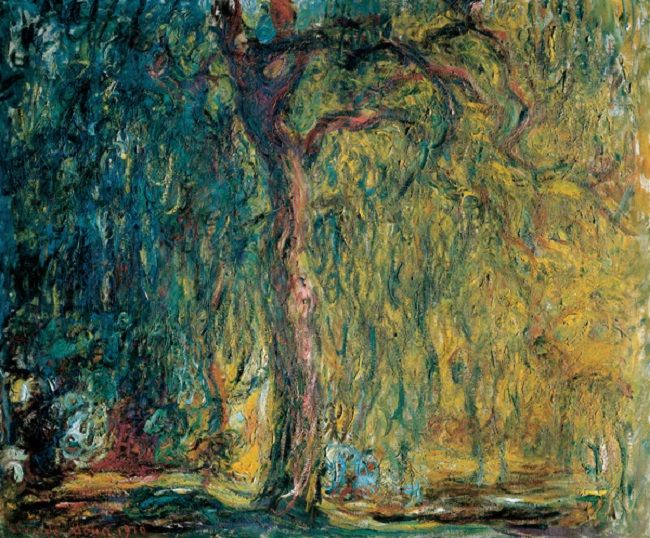
Weeping Willow, Claude Monet
His painting "Water Lilies" was sold for 43 million dollars. Another 10 of his paintings were sold between $ 40 and $ 20 million. Most of Monet's paintings are in the US, Russia and the UK. The "Sunshine Through Mist" Parliamentary Picture is located in Hermitage, St. Petersburg. Another in the "Parliament" series was sold in 2004 for $ 20.1 million at auction, to a private individual. Many of Monet's works are in prestigious museums such as the Metropolitan Museum, the National Gallery of London, the Philadelphia Museum of Art, and others. It is curious to note that many times Monet's canvases have been the subject of theft. The painting "Cliffs near Dipa" has been stolen twice - once in 1998, and the second time in 2007. Thief has replaced the painting "Beach in Purvil" stored in the National Museum of Poland. In October 2012, seven masterpieces were stolen from the Kunstel Rotterdam Museum, including Monet's Waterloo Bridge.
.jpg)
"Argenteuil, Seen from the Small Arm of the Seine" by Claude Monet
Claude Monet's recent years are filled with travel and personal tragedies. Alice's second wife, dying in 1911. His older son Jean died too – By the way he ironically, marries one of Alice's daughters Blanche. It is Blanche that is the woman who continues to take care of Monet in old age. She first noticed the symptoms of cataract and the weakening eyesight of the artist. In 1923, Monet was operated twice to save his eyesight. He has to paint some of his paintings because of the colors in them, red-colored, a symptom typical of this eye disease. The artist has also experienced the stress of the First World War in which many French soldiers died. He worries about his little son Michelle, who is also on the front. His sight and inner anxiety tortured him, but he still painted until his death. Monet dies at age 86 from lung cancer. He is buried in the cemetery of his favorite Giverny. His lily estate is bequeathed by his son Michel at the French Academy of Fine Arts.
Excelent contribution to the community! full of documentation in a great composition! It values much more! reesteem it!
Thank you very much :)
Did you know that fun fact about "water lilies". Monet imported water lilies for his Giverny garden from Egypt and South America, which drew the ire of local authorities. The council demanded he uproot the plants before they poisoned the area's water, but (thankfully) Monet ignored them and gave us this wonderful piece of art!
Hehe, yes! Very nice story! :)
What an incredible story and a fascinating read. Thanks for doing such intricate research and sharing with us the history of such a unique and gifted artists. It is true what they say that truly creative people can be sensitive and moody souls :)
Thank you for the comment :)
You are good atist
still not :)
I love Monet, his work is beautiful and inspiring. The use of light colors in his work is lovely! Thanks for sharing!
You are welcome :)